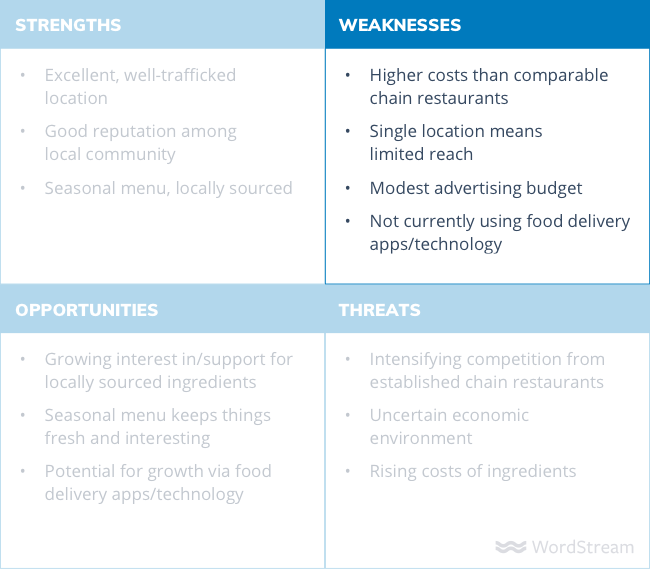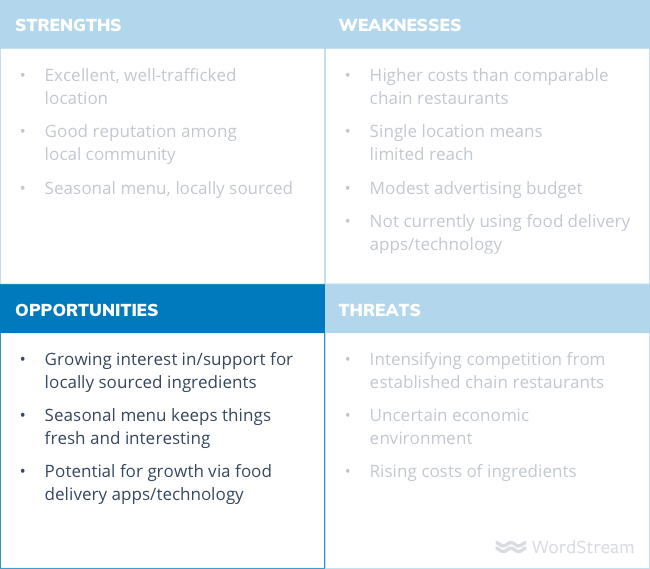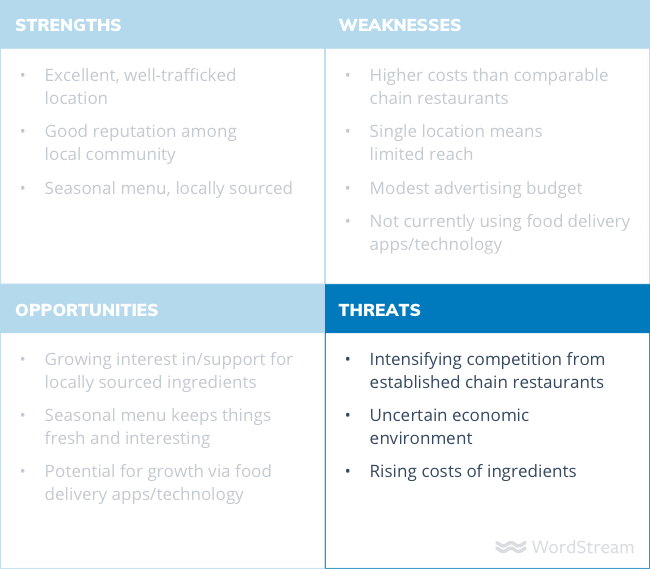So, you’ve finally got your hands on a completed SWOT matrix. You’ve identified internal strengths and weaknesses, as well as external opportunities and threats. You’ve begun to see your company in a whole new light.
Now what?
Ideally, there are two stages of action you should take upon completing a SWOT analysis. First, you should attempt to
match your strengths with your opportunities. Next, you should try to
convert weaknesses into strengths. Let’s take a look how this works.
1. Harness your strengths
One of the best things about the strengths you identified in your SWOT analysis is that you’re already doing them.
In our example above, the restaurant’s location, reputation, and seasonal menu are all strengths. This tells the fictitious company that it should continue to experiment with its popular seasonal menu. It also tells the company it should continue to develop and nurture the strong relationships with its regular customers that have strengthened the restaurant’s reputation in the community.
Essentially, acting upon your business’ strengths consists of “do more of what you’re already good at.”
2. Shore up your weaknesses
Acting on the weaknesses you identified in your SWOT analysis is a little trickier, not least because you have to be honest enough with yourself about your weaknesses in the first place.

Going back to our example, some of these weaknesses are very challenging to act upon. Going up against the considerable purchasing power of rival chain restaurants can be very difficult for smaller, family owned businesses. The restaurant is also struggling with its limited reach, the restrictions of a modest advertising budget, and is also failing to leverage the potential to increase sales by allowing customers to order food online through delivery apps like Foodler or GrubHub.
However, that’s not to say all hope is lost. It might be harder for our example business to compete with a chain, but there are plenty of other ways small companies can be more competitive – such as by developing strong, meaningful relationships with customers, which was not only one of the company’s strengths, but also something chain restaurants simply cannot offer.
3. Seize opportunities
The Opportunities section of your SWOT analysis is by far the most actionable, and that’s by design. By identifying opportunities by evaluating your organization’s strengths, you should have a ready-made list of targets to aim for.

In the example above, increasing consumer appetites for ethically produced, locally grown ingredients is a major opportunity. However, our restaurateurs cannot rest on their laurels – there’s still work to be done. In this example, this may involve investing in technical expertise to take advantage of the opportunities presented by food delivery apps, or sourcing locally grown produce more aggressively in an attempt to reduce costs.
It’s also important to avoid hubris or complacency in your opportunities. Even if you have an iron-clad advantage over every other business in your industry, failing to devote sufficient time, money, or personnel resources in maintaining that advantage may result in you missing out on these opportunities over time.
Every business’ opportunities will differ, but it’s vital that you create a clearly defined roadmap for capitalizing upon the opportunities you’ve identified, whether they be internal or external.
4. Mitigate threats
Anticipating and mitigating the threats identified in your SWOT analysis may be the most difficult challenge you’ll face in this scenario, primarily because threats are typically external factors; there’s only so much you can do to mitigate the potential damage of factors beyond your control.

Every threat, and the appropriate reaction to that threat, is different. Regardless of the specific threats you’ve identified in your SWOT analysis, responding to and monitoring those threats should be among your very top priorities, irrespective of the degree of control you have over those threats.
In the example above, all three threats are particularly challenging. To compete with the prices of its chain competitors, our restaurateurs may be forced to either compromise on their values to secure cheaper ingredients, or willingly cut into their profit margins to remain competitive. Similarly, economic uncertainty is virtually impossible to fully mitigate, making it a persistent threat to the stability of our example restaurant business.
In some SWOT analyses, there may be some overlap between your opportunities and threats. For example, in the
analysis above, the popularity of locally sourced ingredients was identified as an opportunity, and heightened competition was identified as a threat. In this example, highlighting the restaurant’s relationships with local farmers – further reinforcing the restaurant’s commitment to the local community and regional economy – may be an effective way for our restaurateurs to overcome the threat posed by the increasingly desperate chain restaurants vying for their customers.
When compiling the results of your SWOT analysis, be sure to look for areas of crossover like this and see if it’s possible to seize an opportunity and reduce a threat at the same time.



